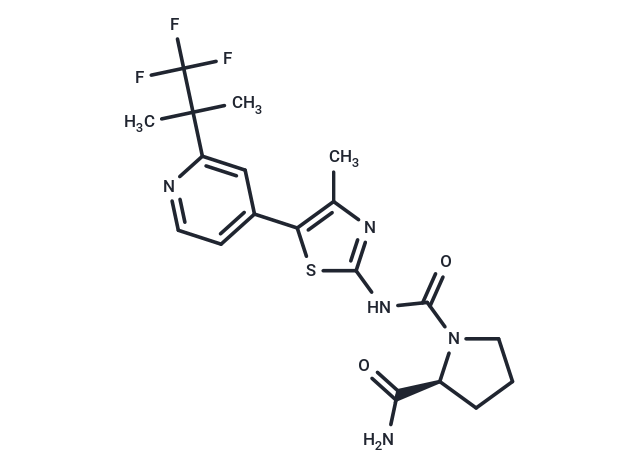Shopping Cart
- Remove All
 Your shopping cart is currently empty
Your shopping cart is currently empty

Alpelisib (BYL-719) is a PI3Kα inhibitor (IC50=5 nM) with selective, potent, and oral activity, inhibiting PI3Kβ/γ/δ with low activity (IC50=250/290/1200 nM). Alpelisib demonstrates antitumor activity and specifically targets PIK3CA mutant tumors.

| Pack Size | Price | Availability | Quantity |
|---|---|---|---|
| 5 mg | $50 | In Stock | |
| 10 mg | $66 | In Stock | |
| 25 mg | $79 | In Stock | |
| 50 mg | $97 | In Stock | |
| 100 mg | $156 | In Stock | |
| 200 mg | $279 | In Stock | |
| 500 mg | $471 | In Stock | |
| 1 g | $688 | In Stock | |
| 1 mL x 10 mM (in DMSO) | $55 | In Stock |
| Description | Alpelisib (BYL-719) is a PI3Kα inhibitor (IC50=5 nM) with selective, potent, and oral activity, inhibiting PI3Kβ/γ/δ with low activity (IC50=250/290/1200 nM). Alpelisib demonstrates antitumor activity and specifically targets PIK3CA mutant tumors. |
| Targets&IC50 | p110α:5 nM (cell free), p110γ:250 nM (cell free) |
| In vitro | METHODS: Osteosarcoma cell lines MG-63, HOS, MOS-J and POS-1 were treated with Alpelisib (0-50 µM) for 72 h and cell viability was measured using XTT assay. RESULTS: Alpelisib significantly inhibited cell growth of all osteosarcoma cell lines in a dose-dependent manner with IC50 ranging from 6-15 µM and IC90 ranging from 24-42 µM. [1] METHODS: PIK3CA wild-type cells (SNU638 and SNU668) and three PIK3CA mutant cells (SNU601, AGS, and MKN1) were treated with Alpelisib (5 µM) for 24 h, and cell cycle profiles were examined using Flow cytometry. RESULTS: Alpelisib treatment induced G0/G1 cell cycle arrest regardless of PIK3CA mutation status. In PIK3CA mutant cells (AGS and MKN1), there was a significant increase in the sub-G1 fraction, suggesting that Alpelisib increased apoptosis in these cell lines. [2] |
| In vivo | METHODS: To assay anti-tumor activity in vivo, Alpelisib (12.5-50 mg/kg, methylcellulose 0.5%) was administered orally to Rj:NMRI-nude mice bearing human osteosarcoma HOS-MNNG once daily for twenty-two days. RESULTS: Alpelisib significantly reduced tumor volume in a dose-dependent manner. [1] METHODS: To investigate the modulatory effects on collagen, Alpelisib (12.5-50 mg/kg) was administered orally to nude mice bearing subcutaneous xenografts of Rat1-myr-p110α tumors once daily for eight days. RESULTS: Treatment with 12.5, 25, and 50 mg/kg of Alpelisib was well tolerated and produced dose-dependent and statistically significant antitumor effects with a T/C of 14.1% and regressions of 9.6% and 65.2%, respectively. [3] |
| Cell Research | To evaluate the isoform-specific potency of NVP-BYL719 in a cell-based system, an N-terminally myristoylated form of each PI3K class IA isoform was expressed in Rat1 fibroblasts. The retroviral expression plasmid pBabePuro containing human p110α, p110β, and p110δ with an N-terminal myristoylation (myr) signal followed by an HA-tag were generated. Successfully infected Rat1 cells were selected in medium containing 4 μg/mL of puromycin, expanded and characterized for expression of the p110 isoforms. Transgenic expression of the myristoylated protein was confirmed by increased levels of phosphorylated Akt [1]. |
| Animal Research | All in life experimentation and efficacy studies were conducted as described previously. Tumor xenografts were grown subcutaneously or orthotopically in nude mice or nude Rowett rats (Hsd: RH-Fox1rnu) by injection of 3 × 10^6 to 1 × 10^7 cells or implantation of tumor fragments of approximately 50 mg. Tumor-bearing animals mice were treated with either vehicle control, NVP-BYL719, or NVP-BKM120 (p.o., every day) at the doses indicated [1]. |
| Alias | BYL-719 |
| Molecular Weight | 441.47 |
| Formula | C19H22F3N5O2S |
| Cas No. | 1217486-61-7 |
| Smiles | Cc1nc(NC(=O)N2CCC[C@H]2C(N)=O)sc1-c1ccnc(c1)C(C)(C)C(F)(F)F |
| Relative Density. | 1.391 g/cm3 |
| Storage | Powder: -20°C for 3 years | In solvent: -80°C for 1 year | Shipping with blue ice. | ||||||||||||||||||||
| Solubility Information | DMSO: 60 mg/mL (135.91 mM), Sonication is recommended. 10% DMSO+40% PEG300+5% Tween 80+45% Saline: 8.2 mg/mL (18.57 mM), suspension.In vivo: Please add the solvents sequentially, clarifying the solution as much as possible before adding the next one. Dissolve by heating and/or sonication if necessary. Working solution is recommended to be prepared and used immediately. Ethanol: 2 mg/mL (4.53 mM), Sonication is recommended. | ||||||||||||||||||||
Solution Preparation Table | |||||||||||||||||||||
DMSO
| |||||||||||||||||||||

Copyright © 2015-2025 TargetMol Chemicals Inc. All Rights Reserved.